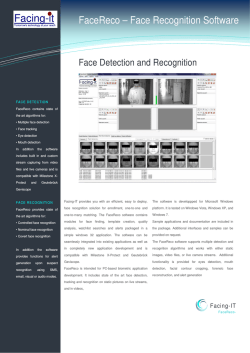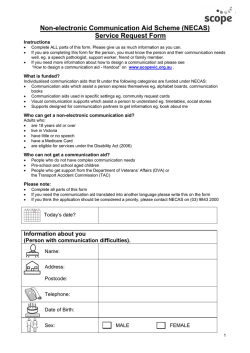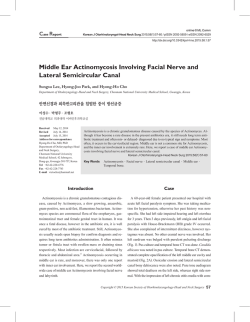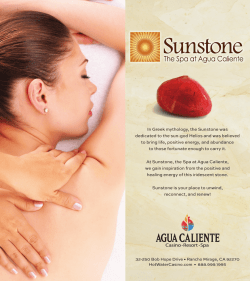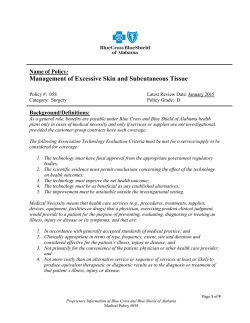
HYALURONIC ACID AS FACIAL FILLER — IMPLICATIONS IN
1 HYALURONIC ACID AS FACIAL FILLER — IMPLICATIONS IN DENTISTRY Ruchielli Loureiro Borghetti, PhDa, Sabrina Pozatti Moure, PhDb, Fernanda Gonçalves Salum, PhDc, Karen Cherubini, PhDc, Maria Antonia Zancanaro de Figueiredo, PhDc* a PhD student of Oral Medicine at the Pontifical Catholic University of Rio Grande do Sul (PUCRS), Porto Alegre, Brazil ([email protected]) b Adjunct Professor at the School of Dentistry, ULBRA, Brazilian Lutheran University, Porto Alegre, Rio Grande do Sul, Brazil b E-mail: [email protected] b Address: Faculdade de Odontologia ULBRA- Graduation Department Rua Farroupilha, 8001, prédio 59- Bairro: São José CEP: 92425-900. Canoas, RS, Brasil. Phone/Fax: +55 51 3464-9692 c Oral Medicine Service of São Lucas Hospital, Pontifical Catholic University of Rio Grande do Sul (PUCRS), Porto Alegre, Rio Grande do Sul, Brazil c E-mail: [email protected] and [email protected] a,c Address: Serviço de Estomatologia do Hospital São Lucas, PUCRS, Pontifícia Universidade Católica do Rio Grande do Sul Av. Ipiranga, 6690 – 2º andar/sala 231, Porto Alegre, RS. Brasil. CEP 90610-000. Corresponding author: *Maria Antonia Zancanaro de Figueiredo ([email protected]) Address: Serviço de Estomatologia do Hospital São Lucas, PUCRS, Pontifícia Universidade Católica do Rio Grande do Sul Av. Ipiranga, 6690 – 2º andar/sala 231, Porto Alegre, RS. Brasil. CEP: 90610-000. 2 Abstract Objective: This study reviews the effects of hyaluronic acid as facial filling substance for cosmetic improvement. The high demand for restoration of facial volume and filling of facial depression has promoted the rapid emergence of new materials in the market. Facial fillers represent a breakthrough in the non-invasive rejuvenation of skin and subcutaneous tissues. Hyaluronic acid is often used in the treatment of wrinkles and in lip augmentation. Methods: The literature published by the National Center for Biotechnology Information (NCBI) was reviewed regarding the description, indications and adverse side effects of hyaluronic acid. Conclusion: The increasing demand for cosmetic procedures and the variety and indiscriminate use of substances currently available for these interventions point to the need to fully investigate adverse reactions that may impair facial esthetics and even put the patient’s general health condition at risk. Keywords: Hyaluronic acid; facial filler; diagnosis; foreign body granuloma Introduction The aging process is influenced by environmental factors, and causes structural and functional changes in organic tissues, among which the depletion of subcutaneous fat and skin collagen levels. The phenomenon reduces skin thickness and elasticity, generating facial depression and folds (1,2), and affecting esthetic appearance. This scenario has encouraged the development of numerous cosmetic facial rejuvenation procedures. Cosmetic surgery has for long been the most commonly adopted approach in facial rejuvenation. Traditionally, the treatment against face aging 3 was based on the surgical traction of tissues (3). In this sense, facial filling techniques have been developed to meet the increasing demand for less invasive procedures that also afford fast recovery and satisfactory looks in the short run. (4). For decades a variety of substances have been used to smooth out wrinkles or folds in the perioral and periocular regions in the skin tissue, to artificially augment lips and the malar region, and to correct facial defects. Ideally, these materials should be safe, efficient, present as few adverse effects as possible, and afford long-term esthetic outcomes (5,6). Recently the use of hyaluronic acid as facial filler has been advocated. This review investigates the influence of this material in the diagnoses of dental conditions and in procedures currently adopted in dentistry. History The augmentation of soft tissues as a means to improve facial esthetics was first considered in 1800, when Neuber reported the use of fat collected from the arm to fill facial depressions. Subsequently, paraffin was also used, though it was soon discovered that it causes granuloma, and was prohibited in 1930. Additionally, soft tissues may suffer unpredictable reactions in the long run, creating the need to study more appropriate and suitable substances to be used as facial fillers. In 1962, liquid silicone was launched as a cosmetic corrective agent, though years later it was banned because of the high potential to cause adverse effects. Starting in 1980 and until recently, bovine collagen was the biomaterial of choice in face filling procedures (7,8). Nevertheless, its use in skin is associated to a 3 percent risk 4 of late hypersensitivity reaction, and requires a double skin test before treatment is started (9,10). This scenario revealed the occurrence of a set of adverse reactions that may impair facial esthetics and even put the patient’s general health condition at risk (6,11). The most important attribute of a facial filler candidate is biocompatibility. However, other characteristics are also important, like nontoxicity, stability to organic fluids and tissues, absence of inflammatory or allergic reaction, resistance to mechanical stress, easy application, and inexpensive removal. In spite of the technological advancements and of the existence of several biomaterials in use, no product currently available in the market meets all these requirements (12). The literature ranks cosmetic fillers into two classes, considering the time these substances remain in tissues: temporary (or resorbable), and permanent (non-resorbable) (13). The advantage of resorbable products lies in the fact that the result may be reverted after some period has elapsed, while permanent fillers require surgical removal in the event of migration or tissue rejection of the material (8). Currently hyaluronic acid (HA) is the most commonly employed resorbable biomaterial in esthetic improvement procedures. It was launched in the market in 1996, and since then several other molecules have been developed for use as facial filler. Product safety is based on the washing-off process of these cross-linking residues, which affords to obtain a pure, atoxic and biocompatible filling material (14,15). Hyaluronic acid injections do not 5 require skin testing, and the literature indicates minimal hypersensitivity risk (1,10,16). Permanence in tissues Due to the fact that it is resorbable, HA is metabolized by enzymes or gradually phagocytized. These processes occur within 3 to 24 months after applications, depending on how much HA is injected in tissues (17). Other authors have reported a gradual absorption of the substance between 6 months and one year after applications, and that mean HA permanence in tissues is 9 months (18-20). Indication The concentration of HA in facial filling procedures is defined based on two main aspects: (1) the depth of wrinkles and expression lines, and (2) the level of augmentation desired (21). As a rule, three concentrations of the product are used. Low concentration HA is used to fill the so-called “smoker lines” that form around the upper lip, as well as crow’s feet. Intermediate concentration HA is used in lip augmentation procedures, while high concentration HA products are injected in nasolabial folds (15,22). Topical, infiltrative or block anesthesia are the main anesthetic measures used to control pain during the injection of the filling material (3,23). Dentistry and facial filling materials In recent times, dentistry professionals have to become increasingly aware of the effects of facial filling materials, since these may affect the facial region and, as a result, the oral cavity. Filling substances are increasingly present in esthetic complementation and oral rehabilitation approaches (7). 6 The presence of facial fillers may change the oral mucosa, leading to confusion or misinterpretation in the diagnosis of dental and oral conditions. With the advent of dental implants, a large number of patients began to replace their total prostheses for fixed protocol prostheses. However, this class of prostheses does not allow the same esthetic result, since the lack of resin flank in these fixed prostheses often increases the nasogenian fold and consequently worsens an aged look. For this reason, the use of fillers in the lower lip and in the nasogenian fold is often suggested to patients who replace their total prostheses with implant-supported dentures. In this case, the aim of filling is to mitigate the aging effect of the loss of lip support. Clinical evaluation of hyaluronic acid filling Although it has been classified as a non-immunogenic substance (24,25), it is known that HA may trigger unfavorable tissue responses, usually due to presence of the remnants of bacterial proteins in the commercial product, to incorrect application or even the presence of a biofilm on the tissue (20). Generally speaking, filling substances may cause a wide array of complications, from a simple inflammatory reaction to tissue necrosis (15,2628), which may become visible immediately or after a longer time lapse after the application. The immediate and/or transient complications are the most common adverse effects of HA fillings. These manifestations may last for up to 14 days, and mostly are related to inflammatory processes or to technical problems (20). Some of these side effects include erythema, ecchymosis and swelling in the region where the product was applied (29-32). Due to injury to 7 a blood vessel during the procedure, hematomas may occur, while necrosis may appear when the injection perforates an artery. These changes have been reported in the glabella and in the nasolabial fold (33,34). Hypersensitivity (35), vasculitis (36) and ischemia (37) have also been observed in some clinical case reports. Biopsy is only seldom prescribed in the occurrence of transient effects (38). However, the procedure is necessary when some clinical signs become apparent, like the migration of the injected material and the formation of foreign body granuloma (39,40). Biopsy is an indicated precautionary measure, because the effects of filling materials may manifest as papules or nodes (39,41,42), and frequently may be mistaken for pathologies with distinct etiology and behavior, like cysts and/or salivary gland neoplasias (42-45). Also, an inflammatory reaction like a granuloma may be observed in the site the exogenous material is injected (46). The process starts with the recruitment of neutrophils and lymphocytes, which is accompanied by pain and exudation. The material injected is invaded by inflammatory cells as soon as it is injected. However, this foreign body is too large to allow phagocytosis by one macrophage only. Therefore, these cells gather together to form giant cells, which measure roughly 40 to 50 μm and aim to isolate the exogenous substance. More intense signs of fibroplasia are observed around the zone of granulomatous inflammation, in a process that occurs in order to limit the tissue response to the presence of the filling material and thus reduce local inflammation. In histological examinations, HA is observed as a blue mass with a bizarre configuration and variable sizes, surrounded by neutrophils, eosinophils and multinucleated giant cells (5,30,39). 8 In 2003, Fernández-Aceñero, Zamora and Borbujo (16) described the case of a patient who presented several nodes in the upper lip caused by an irregular increase in tissue volume that had been evolving for two months. The patient reported having had lip augmentation injections with HA. Based on the assumed diagnosis of foreign body, an incisional biopsy was conducted involving the epidermis, the dermis and subcutaneous adipose tissue. A clearly outlined mass was detected in the subcutaneous adipose tissue plane, and was diagnosed as granuloma. The presence of exogenous material in the biopsied area was confirmed by histopathology. The mechanism through which filling substances trigger a foreign body reaction, the reasons behind the variation in intensity, and the unpredictable character of their mode of action are yet to be elucidated. The filling material often migrates to the oral mucosa (Figure 1), forming a stiff nodule within tissues (47-49). This stresses the need for a complete physical examination that should include visual inspection and tissue palpation. Former use of filling substance is not always reported spontaneously. Several times it is necessary to insist in collecting more thorough information during the interview with a patient in order to obtain as many details as possible concerning past filling material applications. Conclusion The unplanned use of filling materials has revealed a series of adverse reactions that put the esthetic result and the patient’s general health at risk. Even though many professionals of the health industry understand that bioplasty procedures in general are safe and pose no serious hazards to the patient, adverse effects are observed in some cases. These complications 9 may be significant, and include deformity and tissue destruction by an inflammatory response. The low cost of filling substances has led to a widespread adoption of incisionless cosmetic interventions in facial rejuvenation. In this scenario, several professionals of different areas in the health industry have sensed the popularity of these procedures, performing them in their patients, who are exposed to unnecessary and sometimes serious hazards. These patients are often informed of the advantages of these facial fillers, but are unaware of likely adverse effects they may experience after an intervention of this kind. When facial filling is performed by experienced professionals and the correct biomaterial is used, it affords to minimize the effects of age on the skin. Nevertheless, in some circumstances some sequelae may occur. The excessive and indiscriminate utilization of filling materials may point to disappointing issues related to safety and efficacy. Dental surgeons are required to understand these procedures, since the possible adverse effects of filling materials may emulate various pathologies in the orofacial region (50), making it difficult to diagnose and conduct the appropriate clinical management of the patient. Conflict of interest The authors have no conflict of interest. References 1- Brandt FS, Cazzaniga A (2007) Hyaluronic acid fillers Restylane and Perlane. Facial Plast Surg Clin North Am 15(1):63-76. 10 2- Medeiros CC, Cherubini K, Salum FG, de Figueiredo MA (2013) Complications after polymethylmethacrylate (PMMA) injections in the face: a literature review. Gerodontology (in press). 3- Brandt FS, Cazzaniga A (2008) Hyaluronic acid gel fillers in the management of facial aging. Clin Interv Aging 3(1):153-159. 4- Smith KC (2008) Reversfible vs. nonreversible fillers in facial aesthetics: concerns and considerations. Dermatol Online J 14(8):3. 5- Vargas KF, Borghetti RL, Moure SP, Salum FG, Cherubini K, de Figueiredo MA (2012) Use of polymethylmethacrylate as permanent filling agent in the jaw, mouth and face regions-implications for dental practice. Gerodontology 29(2):e16-22. 6- Alijotas-Reig J, Fernández-Figueras MT, Puig L (2013) Late-Onset inflammatory adverse reactions related to soft tissue filler injections. Clin Rev Allergy Immunol 45(1):97-108. 7- Dastoor SF, Misch CE, Wang HL (2007) Dermal fillers for facial soft tissue augmentation. J Oral Implantol 33(4):191-204. 8- John HE, Price RD (2009) Perspectives in the selection of hyaluronic acid fillers for facial wrinkles and aging skin. Patient Prefer Adherence 3:225-230. 9- Lowe NJ, Maxwell CA, Lowe P, Duick MG, Shah K (2001) Hyaluronic acid skin fillers: adverse reactions and skin testing. J Am Acad Dermatol 45(6):930-933. 11 10- Parada MB, Michalany NS, Hassun KM, et al (2005) A histologic study of adverse effects of different cosmetic skin fillers. Skinmed 4(6):345349. 11- de Castro ACB, Collares MVM, Portinho CP, Dias PC, Pinto RA (2007) Extensive facial necrosis after infiltration of polymethylmethacrylate. Braz J Otorhinolaryngol 73(6):850. 12- Lemperle G, Morhenn V, Charrier U (2003) Human histology and persistence of various injectable filler substances for soft tissue augmentation. Aesthetic Plast Surg 27(5):354-366. 13- Edwards PC, Fantasia JE (2007) Review of long-term adverse effects associated with the use of chemically-modified animal and nonanimal source hyaluronic acid dermal fillers. Clin Interv Aging 2(4):509-519. 14- Romagnoli M, Belmontesi M (2008) Hyaluronic acid–based fillers: theory and practice. Clin Dermatol 26(2):123-159. 15- Yeom J, Bhang SH, Kim BS, Seo MS, Hwang EJ, Cho IH, et al (2010) Effect of cross-linking reagents for hyaluronic acid hydrogel dermal fillers on tissue augmentation and regeneration. Bioconjug Chem 21(2):240-247. 16- Fernández-Aceñero MJ, Zamora E, Borbujo J (2003) Granulomatous foreign body reaction against hyaluronic acid: report of a case after lip augmentation. Dermatol Surg 29(12):1225-1226. 12 17- Vargas AF, de Amorim NG, Pitanguy I (2009) Complicações tardias dos preechimentos permanentes. Rev Bras Cir Plast 24(1):71-81. 18- Lemperle G, Morhenn VB, Pestonjamasp V, Gallo RL (2004) Migration studies and histology of injectable microspheres of different sizes in mice. Plast Reconstr Surg 113(5):1380-1390. 19- Perenack J (2005) Treatment options to optimize display of anterior dental esthetics in the patient with the aged lip. J Oral Maxillofac Surg 63(11):1634-1641. 20- Rohrich RJ, Monheit G, Nguyen AT, Brown SA, Fagien S (2010) Soft tissue filler complications: The important role of biofilms. Plast Reconstr Surg 125(4):1250-1256. 21- Burgess CM (2006). Principles of soft tissue augmentation for the aging face. Clin Interv Aging 1(4):349-355. 22- Saylan Z (2003). Facial fillers and their complications. Aesthet Surg J 23(3):221-224. 23- Matarasso SL, Carruthers JD, Jewell ML recommendations for soft-tissue (2006) Consensus augmentation with nonanimal stabilized hyaluronic acid (Restylane). Plast Reconstr Surg 117(3 Suppl):3S-34S. 24- Alijotas-Reig J, Fernández-Figueras MT, Puig L (2013) Inflammatory, immune-mediated adverse reactions related to soft tissue dermal fillers. Semin Arthritis Rheum 43(2):241-258. 13 25- Hamilton RG, Strobos J, Adkinson NF (2007) Immunogenicity studies of cosmetically administered nonanimal-stabilized hyaluronic acid particles. Dermatol Surg 33 (suppl 2):176-185. 26- Fernández-Cossío S, Castaño-Oreja MT (2006). Biocompatibility of two novel dermal fillers: histological evaluation of implants of a hyaluronic acid filler and a polyacrylamide filler. Plast Reconstr Surg 117(6):1789-1796. 27- Monheit GD, Rohrich RJ (2009) The nature of long-term fillers and the risk of complications. Dermatol Surg 35 (suppl 2):1598-1604. 28- Grunebaum LD, Allemann IB, Dayan S, et al (2009) The risk of alar necrosis associated with dermal filler injection. Dermatolgic Surgery 35:1635-1640. 29- Cox SE (2009) Clinical experience with filler complications. Dermatol Surg 35 (suppl 2):1661-1666. 30- Loureiro Borghetti R, de Vargas KF, Pozatti Moure S, Gonçalves Salum F, de Figueiredo MA (2012) Clinical and histologic evaluation of effects of hyaluronic acid in rat tongue. Oral Surg Oral Med Oral Pathol Oral Radiol 113(4):488-494. 31- Rzany B, Cartier H, Kestemont P, Trevidic P, Sattler G, Kerrouche N, Dhuin JC, Ma YM (2012) Full-face rejuvenation using a range of hyaluronic acid fillers: efficacy, safety, and patient satisfaction over 6 months. Dermatol Surg 38(7 Pt 2):1153-1161. 14 32- Lupo MP (2006) Hyaluronic acid fillers in facial rejuvenation. Semin Cutan Med Surg 25(3):122-126. 33- Glaich AS, Cohen JL, Goldberg LH (2006) Injection necrosis of the glabella: protocol for prevention and treatment after use of dermal fillers. Dermatol Surg 32(2):276-281. 34- Bellman B (2006) Complication following suspected intra-arterial injection of Restylane. Aesthet Surg J 26(3):304-305. 35- Patel VJ, Bruck MC, Katz BE (2006) Hypersensitivity reaction to hyaluronic acid with negative skin testing. Plast Reconstr Surg 117(6):92e-94e. 36- Alijotas-Reig J (2009) Recurrent urticarial vasculitis related to nonanimal hyaluronic acid skin filler injection. Dermatol Surg 35 (suppl 1):395-397. 37- Banh K (2013) Facial ischemia after hyaluronic acid injection. J Emerg Med 44(1):169-170. 38- Zimmermann US, Clerici TJ (2004) The histological aspects of fillers complications. Semin Cutan Med Surg 23(4):241-250. 39- Moure SP, de Vargas KF, Borghetti RL, Salum FG, Cherubini K, da Silva VD, de Figueiredo MA (2012) Clinical and pathological characteristics of polymethylmethacrylate and hyaluronic acid in the rat tongue. Int J Oral Maxillofac Surg 41(10):1296-1303. 15 40- Medeiros CC, Borghetti RL, Nicoletti N, da Silva VD, Cherubini K, Salum FG, de Figueiredo MA (2014) Polymethylmethacrylate dermal fillers: evaluation of the systemic toxicity in rats. Int J Oral Maxillofac Surg 43(1):62-67. 41- Jham BC, Nikitakis NG, Scheper MA, et al (2009) Granulomatous foreign-body reaction involving oral and perioral tissues after injection of biomaterials: a series of 7 cases and review of the literature. J Oral Maxillofac Surg 67(2):280-285. 42- da Costa Miguel MC, Nonaka CF, dos Santos JN, Germano AR, de Souza LB (2009) Oral foreign body granuloma: unusual presentation of a rare adverse reaction to permanent injectable cosmetic filler. Int J Oral Maxillofac Surg 38(4):385-387. 43- Quirino MR, Neves AC, Campos MS, Brandão AA, Anbinder AL (2012) Oral granuloma formation after injection of cosmetic filler. J Craniomaxillofac Surg 40(7):e194-197. 44- Gonçales ES, Almeida AS, Soares S, et al (2009) Silicone implant for chin augmentation mimicking a low-grade liposarcoma. Oral Surg Oral Med Oral Pathol Oral Radiol Endod 107(4):e21-e23. 45- Maly A, Regev E, Meir K, et al (2004) Tissue reaction to liquid silicone simulating low-grade liposarcoma following lip augmentation. J Oral Pathol Med 33(5):314. 16 46- Lombardi T, Samson J, Plantier F, Husson C, Küffer R (2004) Orofacial granulomas after injection of cosmetic fillers. Histopathologic and clinical study of 11 cases. J Oral Pathol Med 33(2):115-120. 47- Lee SC, Kim JB, Chin BR, Kim JW, Kwon TG (2013) Inflammatory granuloma caused by injectable soft tissue filler (Artecoll). J Korean Assoc Oral Maxillofac Surg 39(4):193-196. 48- Eversole R, Tran K, Hansen D, Campbell J (2013) Lip augmentation dermal filler reactions, histopathologic features. Head Neck Pathol 7(3):241-249. 49- Feio PS, Gouvêa AF, Jorge J, Lopes MA (2013) Oral adverse reactions after injection of cosmetic fillers: report of three cases. Int J Oral Maxillofac Surg 42(4):432-435. 50- Vargas KF, Borghetti RL, Moure SP, Cherubini K, de Figueiredo MA (2014) Local and systemic tissue response submitted to injection of 2 and 30% polymethylmethacrylate in rats' tongue. Gerodontology (in press). 17 Fig 1. Clinical view: submucosal node at the lower right lip.
© Copyright 2025

